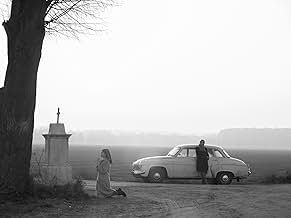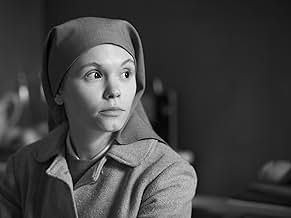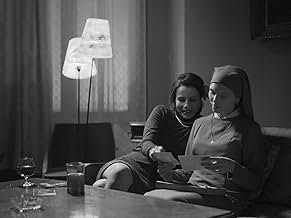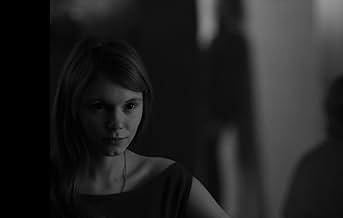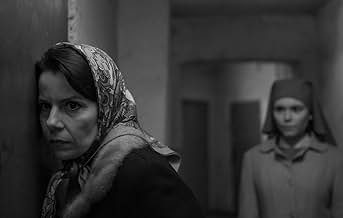IMDb-BEWERTUNG
7,4/10
62.301
IHRE BEWERTUNG
Anna, eine junge Novizin im Polen der 1960er-Jahre, steht kurz vor der Ablegung ihrer Gelübde, als sie ein dunkles Familiengeheimnis aus der Zeit der Nazibesetzung entdeckt.Anna, eine junge Novizin im Polen der 1960er-Jahre, steht kurz vor der Ablegung ihrer Gelübde, als sie ein dunkles Familiengeheimnis aus der Zeit der Nazibesetzung entdeckt.Anna, eine junge Novizin im Polen der 1960er-Jahre, steht kurz vor der Ablegung ihrer Gelübde, als sie ein dunkles Familiengeheimnis aus der Zeit der Nazibesetzung entdeckt.
- Regie
- Drehbuch
- Hauptbesetzung
- 1 Oscar gewonnen
- 70 Gewinne & 92 Nominierungen insgesamt
Natalia Lange
- Bronia
- (as Natalia Lagiewczyk)
Jan Wojciech Poradowski
- Father Andrew
- (as Jan Wociech Poradowski)
Empfohlene Bewertungen
In the 60's Poland, a few days before pronouncing her vows of poverty, chastity and obedience to end her probation period and officially become a nun, Anna, an orphaned young woman, learns by chance the existence of her aunt, Wanda. The Mother Superior propose to Anna to meet Wanda. In this respect, she offers her to take all the necessary time. This encounter will turn her life upside down, via a journey of self-discovery and a road trip through rural Poland, in search of lost time. Lost forever...
Shot in gorgeous black and white, this film is a disconcerting beauty while remaining simple and pure, with a neat photography, elegant and appropriate framings highlighting the emptiness and the sadness of certain existences, and a careful treatment of natural light. Then, the two main actresses, Agata Kulesza and Agata Trzebuchowska, are prodigious and complement each other wonderfully. Finally, the script is excellently and soberly written, and, even if the film is hard and deals with an unpleasant subject, the staging is simple and anything but egghead. As a synthesis, the film is a masterpiece.
Shot in gorgeous black and white, this film is a disconcerting beauty while remaining simple and pure, with a neat photography, elegant and appropriate framings highlighting the emptiness and the sadness of certain existences, and a careful treatment of natural light. Then, the two main actresses, Agata Kulesza and Agata Trzebuchowska, are prodigious and complement each other wonderfully. Finally, the script is excellently and soberly written, and, even if the film is hard and deals with an unpleasant subject, the staging is simple and anything but egghead. As a synthesis, the film is a masterpiece.
Ida is the small and simple story of a complex and terrible past that gets unearthed when a nun discovers she is Jewish. Before taking her vows, she is sent out to meet her aunt, a bitter woman who drinks too much from the life and miserable aftermath of a Nazi occupied Poland. They journey in search of Ida's murdered parents and their resting place and what unfolds is simple, raw storytelling and plotting that is never overly grim, overly dramatic or hits a false note. Beautifully shot in black and white and with a short 80 minute running time that doesn't allow a moment of fat in this narrative, Ida is a rewarding experience.
While French artsy-critic magazine "telerama" gave it an ecstatic review, there is one thing I wasn't prepared for: the quality of the images. Set in an almost-but-not-quite faded black and white, of about completely square format, I was sure the movie, set and shot in Poland, was using some obscure last reels of some obscure special negatives, developed in a forgotten cold-war era lab... Well, according to the credits, that was all digital, from start to finish. All the haters of DDD processes out there (I'm one of them), we can now be assured the modern film-maker has today the ability to really work on grain, under-exposure, blurred shadows and all that; Wiene, Murneau, Dreyer, Eisenstein and Lang be damned.
I was stunned. This, and the quite audacious camera angles, the ever so close close-ups that only half a face remains visible. I even noticed what should be considered an error (walking in the forest, you only see the characters up from their ankles, missing their feet labouring trough the undergrowth)... And it just works because of the richness of the various tree trunk's winter greys.
Add to that the settings, the aesthetics of semi-derelict post-war communist décor, and the odd 'innocent girl meets nice boy' arch-cute scene, but that was to be expected from the start, even if it is just about perfect. The Hotel is... A graphic masterpiece in itself.
So yeah, the movie is worth it's weight on that alone already, and then there is Agata Kulesza, so absolutely right every part of her role as Aunt Wanda, so whole and complex inside a movie that doesn't otherwise spend lengths on character's backgrounds that she just draws you inside, whether you know her story, her past, her issues or not. A jaw-dropping performance.
This movie should not be called Ida, but Wanda.
I was stunned. This, and the quite audacious camera angles, the ever so close close-ups that only half a face remains visible. I even noticed what should be considered an error (walking in the forest, you only see the characters up from their ankles, missing their feet labouring trough the undergrowth)... And it just works because of the richness of the various tree trunk's winter greys.
Add to that the settings, the aesthetics of semi-derelict post-war communist décor, and the odd 'innocent girl meets nice boy' arch-cute scene, but that was to be expected from the start, even if it is just about perfect. The Hotel is... A graphic masterpiece in itself.
So yeah, the movie is worth it's weight on that alone already, and then there is Agata Kulesza, so absolutely right every part of her role as Aunt Wanda, so whole and complex inside a movie that doesn't otherwise spend lengths on character's backgrounds that she just draws you inside, whether you know her story, her past, her issues or not. A jaw-dropping performance.
This movie should not be called Ida, but Wanda.
simplicity, great photographs, splendid script. at first sigh, an old fashion movie. in fact, wise manner to use the legacy of impressive tradition and a great director who use, in same measure, with same precision, tension, poetry of images, atmosphere of period, cultural roots. it is a reflection occasion about origins, truth, faith and choices. a profound Polish story who reflects the identity search of an entire continent. it is , certainly, a rare gem. the cause is not only beauty of photography or admirable acting but a special flavor who remains after its end as a delicate feeling. a young woman and the courage to become here self. that is all. in skin of seductive music.
Whereas Jacques Rivette's despairing 'La Religieuse' had been shot in incongruously pretty sixties Eastmancolor, this laconic but wryly good-humoured female road movie - like Ingmar Bergman's Persona' - gains much of it's seductive visual impact from being shot in coolly glacial monochrome that looks like what you'd have got if Vermeer had worked in charcoal.
Similarly, like the Scandinavian good looks of Liv Ullman and Bibi Andersson in Bergman's film, 'Ida' is fascinating to watch throughout simply for the strong Polish features of Agata Kulesza as the chain-smoking 'Red Wanda' and the button eyes of Agata Trzebuchowska in the title role.
Similarly, like the Scandinavian good looks of Liv Ullman and Bibi Andersson in Bergman's film, 'Ida' is fascinating to watch throughout simply for the strong Polish features of Agata Kulesza as the chain-smoking 'Red Wanda' and the button eyes of Agata Trzebuchowska in the title role.
Wusstest du schon
- WissenswertesPawel Pawlikowski had such difficulty finding an actress to play the titular character that he asked his friends to take secret photographs if they saw anyone who was in the right ballpark of the character. One of his friends, director Malgorzata Szumowska, saw Agata Trzebuchowska in a Warsaw café, took the picture and persuaded her to audition. She agreed to meet with Pawlikowski because she was a fan of his film My Summer of Love (2004).
- PatzerWhen Ida is in a church, the priest seems to be getting ready to say Mass and we see a versus populum altar, which didn't become the norm until years later after Vatican II. The movie takes place in 1961 and the priest would have been saying Mass on the high altar.
- VerbindungenFeatured in 72nd Golden Globe Awards (2015)
- SoundtracksSerduszko puka w rytmie cha-cha
Music by Romuald Zylinski
Lyrics by Janusz Odrowaz-Wisniewski
Performed by Maria Koterbska
Top-Auswahl
Melde dich zum Bewerten an und greife auf die Watchlist für personalisierte Empfehlungen zu.
- How long is Ida?Powered by Alexa
Details
Box Office
- Budget
- 1.000.000 $ (geschätzt)
- Bruttoertrag in den USA und Kanada
- 3.827.060 $
- Eröffnungswochenende in den USA und in Kanada
- 55.438 $
- 4. Mai 2014
- Weltweiter Bruttoertrag
- 11.156.836 $
- Laufzeit
- 1 Std. 22 Min.(82 min)
- Farbe
- Sound-Mix
- Seitenverhältnis
- 1.37 : 1
Zu dieser Seite beitragen
Bearbeitung vorschlagen oder fehlenden Inhalt hinzufügen



